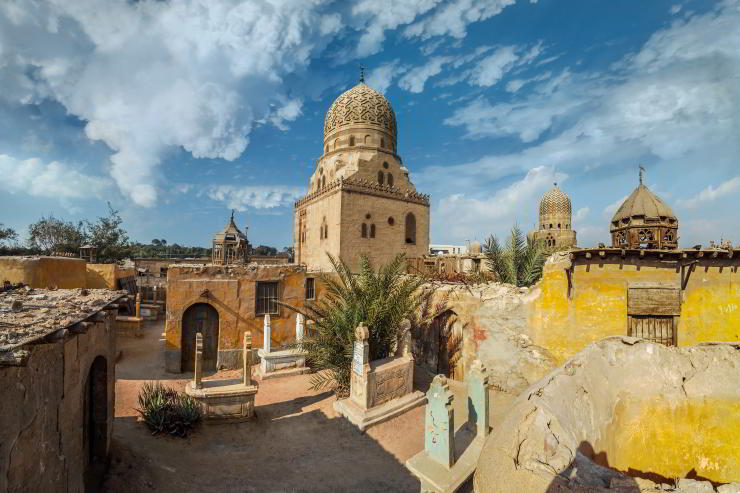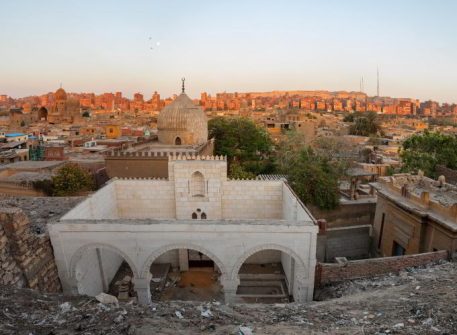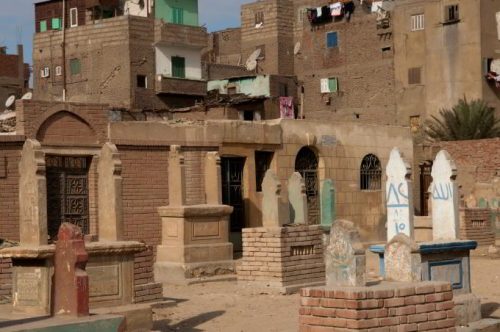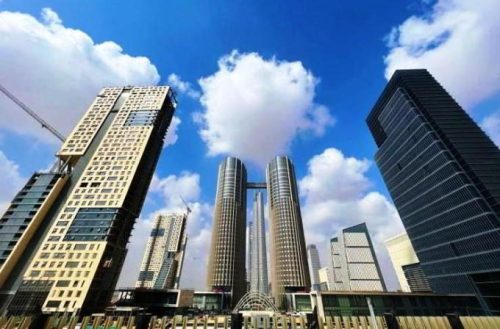Egypt. The end of the City of the Dead.

With an investment of billions of euros, the new administrative capital of Egypt is one of the main projects of President Al Sisi. Its development will lead to the disappearance of the City of the Dead,
an emblem of Cairo.
An uncomfortable silence. You can’t hear the noise of cars stirring up dust or the dry earth of the ground. Not even the call to prayer and the solemnity of the verses from the Quran can break the weight of a unique place. In the labyrinth of the City of the Dead in Cairo, Egypt, curious eyes occasionally peek behind the tattered curtains of the windows and under the frames of the doors that welcome the mausoleums that house the tombs of about a million Cairenes.Three men collect the bricks that they had using a few days earlier to build a house and, with the help of a rusty wheelbarrow, form small mounds of debris. In the background, three ruined walls reveal the asphalt road that surrounds the City of the Dead, also known as Al-‘Arafa.

General view of the Northern Cemetery, part of the City of the Dead in Cairo, Egypt. 123rf
A woman appears in the door-frame of her house. Accompanied by one of her daughters, she allows a glimpse of the living room of the house. In the centre of the room is the tomb of an unknown person. She nods and, a couple of seconds later, disappears into her house.
The City of the Dead, one of the oldest active necropolises in the world, with over 14 centuries of history, has been sacrificed to the urban development plans of Egyptian President Abdelfatah al-Sisi.
In May 2023, the country’s government began demolishing the historic mausoleums, despite opposition from UNESCO and their status as a World Heritage Site since 1979.
The Egyptian leader’s new plan calls for connecting downtown Cairo with the new administrative capital, a road that will result in the demolition of tombs over 1,300 years old, including those of Taqi al-Din al-Maqrizi,
a Cairo historian.
Dual immigration
It was during the 20th century that the City of the Dead began to be densely populated due to several historical and social factors. During the 1950s and 1960s, Cairo experienced unprecedented population growth, driven by rural migration to urban areas that outstripped the capacity of urban centres to accommodate the new inhabitants.Due to political inaction and the absence of urbanization policies that failed to meet the demand for affordable housing, thousands of people left the city centre in search of alternatives in uninhabited areas, even cemeteries.

The City of the Dead, one of the oldest active necropolises in the world, has been sacrificed to the urban development plans of Egyptian President Abdelfatah al-Sisi. 123rf
This massive interurban relocation coincided with two major war crises in the region: the Six-Day War in 1967 and the Yom Kippur conflict in 1973. Both events contributed to the displacement of entire communities.Seeking temporary refuge, thousands of families found short-term accommodation in the City of the Dead, whose mausoleums feature underground rooms and courtyards. What was supposed to be a temporary outlet has become the most populated necropolis in the world, in the absence of government intervention to prevent it.
Demolition and eviction of families
The demolition of houses in the city of the dead began in 2019. There are no precise figures on the exact number of people involved since the central government does not relocate them and non-governmental organizations do not have free and guaranteed access to the area. Eviction notices have been posted on the fronts of hundreds of houses notifying residents of the imminent demolition of their homes.
The demolition of the historic necropolis is due to the project to build a highway connecting the centre of Cairo to the new administrative capital, one of the urban whims of the current president. The route and planning of the new road passes over the City of the Dead, indifferent to its inhabitants and its historical importance.
These initiatives, although led by the central government, also have the support of local authorities in Cairo, in particular Major General Ibrahim Abdel Hady, deputy governor of the western region of the capital. The last stretch of dirt road, just levelled, coincides with the curve of an already paved road, where traffic is very heavy. When it joins the asphalt strip, after more than 60 kilometres, a row of skyscrapers stands out in the middle of the desert. This is the new administrative capital.

Graves inside the City of the Dead district in the suburbs of Cairo. Shutterstock/John Wreford
The tall buildings are accompanied by a couple of whitewashed mosques, whose marble floors do not shine, and by a hundred or so houses built and still uninhabited. It is an oasis of 730 square kilometres intended for the political, economic and ministerial upper classes, a refuge for the country’s oligarchs.
Construction work on the project began in 2017 and involved a workforce of 150,000 people. According to official data, 23 billion euros were spent on the first phase of construction alone, which is scheduled for completion in 2030. Near the new presidential palace and in front of the Arc de Triomphe, there is a grandstand with a capacity of about 500 spectators. At the top, engraved in gold, is the eagle of Saladin holding the Egyptian national flag on its chest.
In addition to political influence, military influence is also present in the project for the new administrative capital. A public company, 51% financed by the armed forces, is leading the construction work. 29% is owned by the Egyptian Ministry of Housing.
The Mark of China
The project was first unveiled in March 2015 in Sharm el-Sheikh, about a year after Sisi came to power in Egypt. Initially, the plans were led by a consortium close to Emaar, a construction company from the United Arab Emirates, and SOM, an architectural firm from the United States. At the end of the same year, coinciding with the official visit of Chinese President Xi Jinping, Sisi decided to hand over the construction contract to the China State Construction Engineering Corporation (CSCEC), a Chinese public entity. CSCEC is the world’s largest construction company and the eighth largest contractor in terms of sales in the foreign market. In addition to its role in the new administrative capital, there are several Chinese-led projects in Egypt.

Central Business District (CBD) of the New Administrative Capital of Egypt. The construction contract is in the hands of the China State Construction Engineering Corporation (CSCEC), a Chinese public entity. CC BY-SA 4.0/Mahan84848)
For example, in the China-Egypt Economic and Trade Cooperation Zone, near the Suez Canal, it has built a development area that houses Chinese and Egyptian companies in sectors such as textiles, machinery and petrochemicals, among others. China has also collaborated on the electrified light rail project that connects Cairo with another of the most urbanized peripheral cities in the area, the city of 10 Ramadan.
China’s influence also permeates other sectors, such as culture. Chinese archaeological teams collaborate with Egypt on joint excavations, such as at the Temple of Montu in Luxor, as well as other educational collaboration programs. (Open Photo: Ancient minarets of the tombs in the City of the Dead in Cairo. Shutterstock/akimov Konstantin)
Soraya Aybar Laafou



